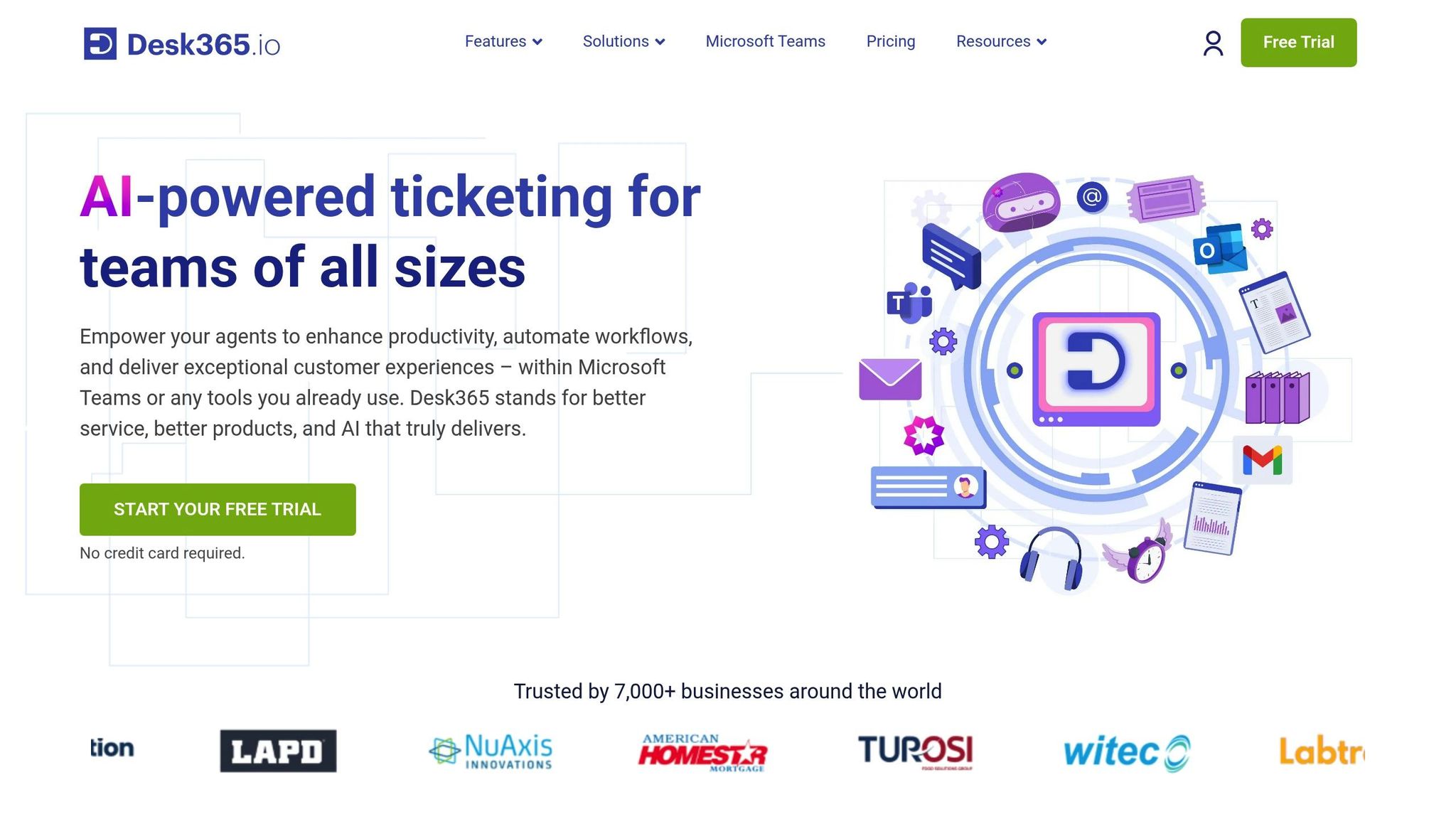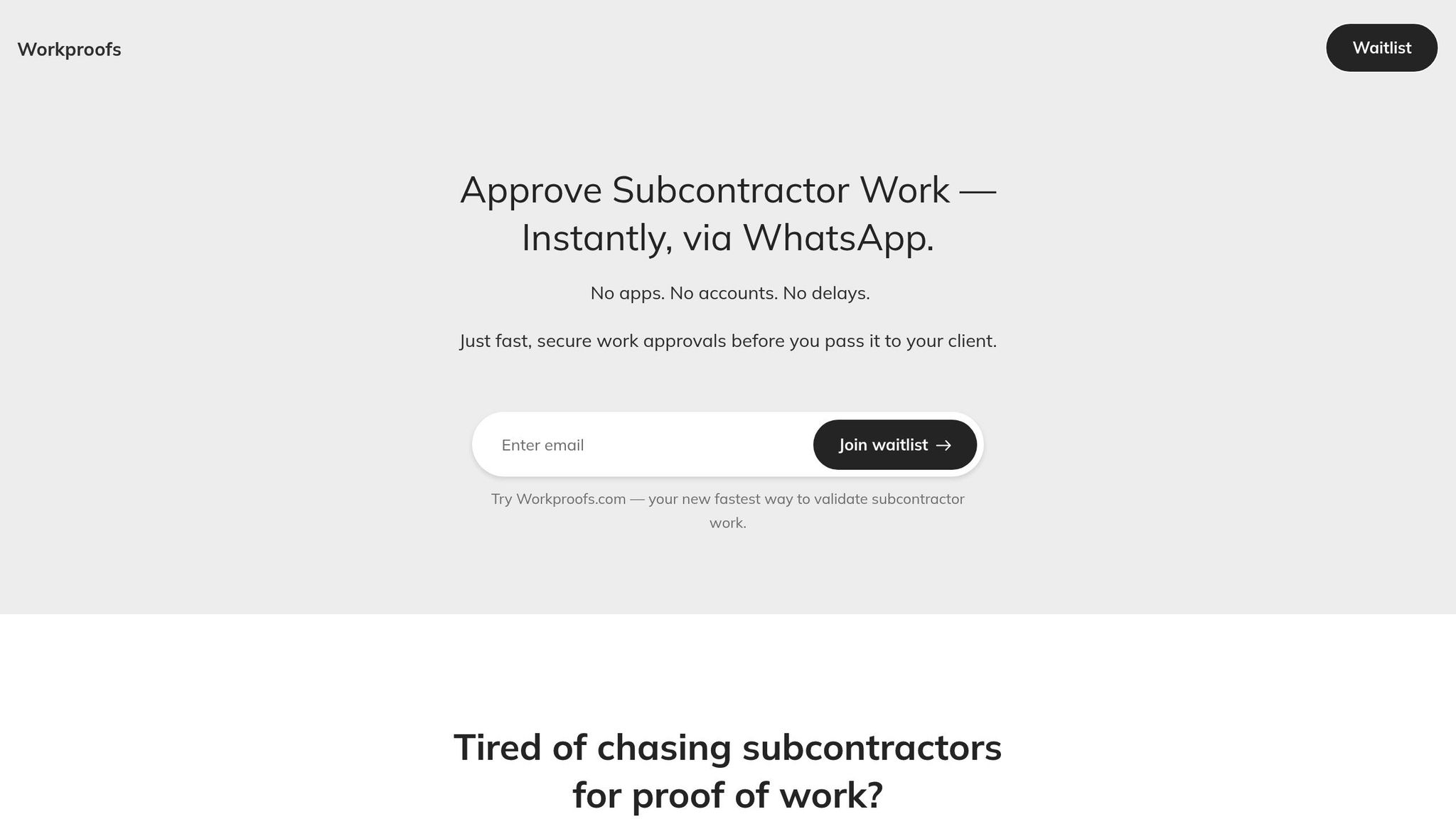If your work approval process is causing delays, confusion, or frustration, it’s time to fix it. Broken workflows waste time, drain resources, and damage trust. Here’s how to spot the signs and take action:
-
Common Problems:
- Lack of clarity: No one knows who approves what.
- Poor tracking: You can’t see the status of approvals.
- Miscommunication: Errors pile up due to unclear feedback.
- Scattered documentation: Missing or disorganized records lead to disputes.
-
Why It Happens:
- No written workflow: Teams rely on informal, inconsistent processes.
- Overly complex tools: Hard-to-use systems lead to shortcuts.
- High staff turnover: New hires slow things down without proper training.
- No tracking system: Accountability gaps cause delays.
-
Quick Fixes:
- Write down clear roles and steps for approvals.
- Use simple tools with real-time tracking (like Workproofs.com).
- Centralize documentation for easy access and accountability.
- Train staff regularly to ensure everyone stays on the same page.
An efficient approval process saves time, reduces errors, and improves team morale. Start by identifying your biggest bottlenecks and implement straightforward solutions to streamline your workflow.
Mastering Change/Approval Management with Desk365

Signs Your Work Approval Process Is Broken
A flawed approval process often reveals itself through daily headaches and inefficiencies. As discussed earlier, broken workflows can significantly impact productivity - and the signs of a failing approval system are hard to miss. In fact, inefficiencies cost companies 20–30% of their revenue annually. Approval bottlenecks, often hidden, are a major contributor to these losses. Here’s how to recognize if your workflow is in trouble.
No One Knows Who Approves What
When questions like, "Who’s supposed to approve this?" or "Has anyone reviewed this yet?" become common, it’s a clear sign that roles and responsibilities are unclear. This lack of clarity creates accountability gaps, leaving tasks in limbo.
For instance, imagine a subcontractor submits a photo for review, but it sits untouched because multiple managers assume someone else is handling it. This not only delays client feedback but also exposes the team to inconsistent quality control. Without a well-defined process, confusion takes over, and accountability becomes a guessing game.
You Can't Track Approval Status
If finding out the status of an approval requires endless emails or hopping between platforms, your tracking system is failing. Bottlenecks in the approval process can cause major delays, and poor visibility makes it even harder to pinpoint and fix the problem.
Teams today need real-time transparency. If managers can’t quickly see which submissions are pending, approved, or require revisions, projects inevitably slow down. Disorganized tracking systems waste valuable time and lead to frustration, pulling focus away from productive work.
And when tracking systems falter, miscommunication often follows.
Constant Miscommunication and Errors
"The most common cause of project failure is miscommunication." - Sahil Kumar Arora, Maldives Transport and Contracting Company Plc
When approval processes depend on unclear communication, errors pile up. Research shows that for every $1 billion spent on projects, $135 million is at risk due to poor communication - and $75 million of that is directly tied to ineffective communication strategies.
Examples of this include outdated deliverables, approvals lost in email threads, or repeated requests for the same information. A dramatic illustration of miscommunication's cost is the Mars Climate Orbiter crash in the late 1990s. NASA engineers used imperial measurements, while their European counterparts used metric, resulting in a $125 million mission failure. In the context of approval workflows, unclear communication can lead to missed quality checks, deliverables that fail to meet client expectations, and expensive rework.
Missing or Scattered Documentation
When approval records are scattered across emails, chat messages, and verbal agreements, your team is set up for failure. Relying on paper documents or manual processes only adds to the chaos. This lack of organization makes it nearly impossible to audit approvals or verify that work was signed off before delivery.
Missing documentation creates significant accountability issues. If a client questions a deliverable or a project runs into problems, having a clear record of who approved what - and when - becomes crucial. Without this, disputes can devolve into finger-pointing, damaging professional relationships.
Inefficient processes like these cost organizations around $1.3 million annually. Much of this loss comes from time wasted recreating lost approvals, redoing work that wasn’t properly documented, and resolving conflicts caused by unclear approval histories. The more scattered your documentation, the harder it becomes to maintain a clear and reliable record of decisions, approvals, and responsibilities.
Why Approval Processes Break Down
When approval processes fail, it often leads to delays, confusion, and frustration. Understanding what causes these breakdowns can help teams address issues before they escalate. According to research from McKinsey and Company, a staggering 70% of large-scale, complex change initiatives don’t succeed. These failures are often rooted in systemic problems.
"Business process failures are the organizational equivalent of a car's check engine light. Everyone dreads seeing them, and ignoring them only makes things worse. It's fascinating because, despite all our advances in management theory and technology, we still see companies stumbling over the same hurdles time and time again."
– Sally Derian, Founder, 4D Intel
Let’s explore some of the key reasons approval processes fall apart.
No Written Workflow Process
One major issue is the absence of a documented workflow. Many teams rely on informal processes that exist only in people’s heads. Without a clear, written procedure, managers often apply inconsistent review cycles, leading to confusion and unpredictable results. This lack of standardization causes unclear roles, missed deadlines, and wasted time. In fact, 92% of missed deadlines are directly tied to approval delays.
When workflows aren’t documented, new team members struggle to grasp expectations, while experienced staff may interpret tasks differently. Teams often spend unnecessary time seeking clarity before they can even begin their work. This not only delays progress but also creates frustration across the board.
Tools Are Too Complicated to Use
Another common problem is overly complex tools that make following proper procedures a challenge. When systems are difficult to navigate, team members often take shortcuts or bypass the process entirely. This issue is particularly problematic for subcontractors, freelancers, or field workers who may lack the technical skills needed to navigate intricate systems. As a result, informal methods creep in, leading to gaps in documentation and accountability.
High Staff Turnover Disrupts Training
High turnover rates are another significant factor that disrupts workflows. When employees leave frequently, institutional knowledge is lost, and new hires require time to learn the ropes. This learning curve can slow productivity by up to 30% as new team members gradually get up to speed.
With nearly 20% of employees leaving their jobs annually as of 2018, workflows are often in a constant state of disruption. Remaining employees are left to pick up extra responsibilities while training newcomers, which can lower morale and create further inconsistencies in the process.
No Way to Track Who Approved What
A lack of proper tracking systems adds yet another layer of dysfunction. Without clear records of who approved what, accountability becomes nearly impossible. This makes it difficult to identify and address weak points in the process.
"When setting expectations, no matter what has been said or written, if substandard performance is accepted and no one is held accountable - if there are no consequences - that poor performance becomes the new standard. It starts with the individual and spreads to each of the team members until this becomes the culture, the new standard."
– Jocko Willink, Retired Navy SEAL Officer and Author
sbb-itb-57e8e01
How to Fix Approval Process Problems
Once you've pinpointed the issues in your approval process, it's time to take action. With the right steps and tools, you can bring back clarity and accountability.
Write Down Who Does What
Start by mapping out a clear, written workflow that defines who is responsible for each approval. This should include details about vendors, budgets, monetary limits, and purchase types. For instance, marketing materials might need the creative director’s approval, while technical deliverables could require sign-off from the project manager.
Your workflow should outline specific goals, approval steps, responsibilities, deadlines, and how documentation will be handled. Include backup approval processes for when the primary approver is unavailable to avoid delays. Consider unique factors like geographic locations, product categories, or department needs. For instance, a construction company might have distinct approval requirements for East Coast versus West Coast projects.
Use Tools That Are Easy for Everyone
Pick tools that your team can use without needing extensive training. The best options offer customizable workflows and real-time tracking, giving everyone a clear view of the process.
Simple tools can streamline approvals and prevent bottlenecks. For example, teams working with subcontractors or field workers might benefit from solutions like Workproofs.com. This platform allows subcontractors to submit photos, files, or text via WhatsApp, while managers can approve or request changes with a single tap. No complex apps, logins, or lengthy training sessions are required.
Keep Records of All Approvals
Tracking every approval is key to maintaining accountability. Implement a system that logs all decisions, including timestamps, comments, and any requested changes. A cloud-based system is ideal, as it lets team members check approval statuses from any device.
Choose tools that prioritize security to protect sensitive information. Look for platforms with detailed audit trails and seamless integration with your existing systems. Strong documentation ensures your team can easily access past approvals and stay organized.
Train Staff Regularly
Regular training is a must, especially in organizations with high staff turnover. New employees should not only learn how to use the tools but also understand the importance of the approval process. This includes how it helps prevent mistakes, safeguards client relationships, and ensures quality.
Work with vendors that provide detailed training materials, customer support, and technical assistance. This will make onboarding smoother and help your team address any issues that come up along the way. Regular refreshers can also keep everyone aligned and confident in the process.
How Workproofs.com Fixes Broken Approval Workflows

If your approval process feels more like a roadblock than a solution, it’s time to address the underlying issues. Workproofs.com steps in to simplify submissions, automate record-keeping, and make training less of a headache. Plus, it integrates with tools your team already uses, making it a practical fix for common workflow challenges.
Simplified Submissions with WhatsApp

One of the biggest hurdles in approval workflows is getting submissions in the first place. Many traditional systems rely on clunky interfaces that can overwhelm subcontractors and field workers. Workproofs.com changes the game by connecting directly to WhatsApp - a platform most people already use daily.
With this integration, subcontractors can submit photos, files, or updates straight from their phones. Picture a construction worker capturing a quick photo of finished work or a freelance designer sending logo drafts - all done effortlessly through WhatsApp. By aligning with everyday habits, Workproofs.com keeps the approval process moving without unnecessary friction.
A Centralized Record of Every Approval
Broken workflows often result in scattered documentation - emails here, texts there, and verbal approvals that vanish into thin air. This lack of organization not only disrupts quality control but also leaves businesses exposed when clients question deliverables or timelines.
Workproofs.com solves this by automatically logging every submission and decision in one place. From the initial task submission to the final approval, everything is tracked for full traceability. This centralized system protects your business, ensures compliance, and highlights bottlenecks so you can continually refine your processes.
Designed for High Turnover Teams
Industries like construction, creative services, and logistics often deal with frequent staff changes and varying levels of technical know-how. Traditional approval systems that require extensive training can be a constant drain on time and resources.
Workproofs.com eliminates this issue with its straightforward design. New team members can get up to speed quickly, and managers can approve tasks with just a tap. Whether you're managing a global team or working with remote freelancers, this platform ensures the workflow stays consistent - even when the team doesn’t. Its simplicity and accessibility make it an ideal tool for navigating workforce challenges while keeping projects on track.
Conclusion: Fix Your Approval Process Now
An inefficient approval process doesn’t just slow things down - it drains resources. Organizations lose about $1.3 million annually due to inefficient task management, and miscommunication costs U.S. businesses an average of $12,506 per employee each year. These numbers highlight missed opportunities and strained client relationships that could have been avoided.
The good news? You don’t need to start from scratch to fix it. Begin by evaluating your current workflow to identify where delays and missteps occur. Introduce a straightforward intake form to standardize how requests are initiated, and establish a central system to capture and route all requests effectively.
Once you’ve pinpointed the problem areas, focus on solutions that prioritize accountability and efficiency. Streamlining your process can significantly reduce waiting times and bottlenecks. Companies that adopt structured review systems often experience 50% faster approvals and 50% fewer revision cycles. These improvements not only enhance productivity but also boost client satisfaction and your bottom line.
The challenges grow even more complex when managing remote or distributed teams. Without clear accountability, 66% of remote employees report feeling disconnected, which can lead to missed deadlines and quality issues. Tools like Workproofs.com can simplify this by automating approval workflows and tracking progress, ensuring consistency and accountability across teams.
Now’s the time to take action. Map out your current process, identify the biggest bottlenecks, and implement targeted solutions that address the root causes. A well-designed approval workflow should empower your business and strengthen client relationships - not hold them back. By refining your approach and leveraging the right tools, you can create a process that delivers real results.
FAQs
What are the warning signs of bottlenecks in my work approval process, and how can I identify them?
Bottlenecks in your work approval process can rear their heads in various ways - missed deadlines, extended approval times, repeated revisions, or overwhelmed team members. These challenges often result in delays, mistakes, and mounting frustration across the board.
To identify where things are getting stuck, start by mapping out your workflow. Look closely at points where tasks consistently pile up or progress slows. Pay special attention to stages or individuals where delays occur repeatedly. Regularly reviewing your process and gathering input from your team can shed light on the root causes behind these slowdowns.
For a straightforward solution to smooth out approvals, consider tools like Workproofs.com. This platform enables quick, trackable proof-of-work submissions and approvals through WhatsApp. It’s particularly useful for teams managing subcontractors or remote workers. By simplifying the workflow, you can minimize errors, boost accountability, and keep your projects moving forward.
How can I improve communication and avoid errors in my work approval process?
To make your work approval process smoother and less prone to errors, start by laying a solid foundation: clearly define roles and responsibilities for everyone involved. This ensures that each person knows exactly what’s expected of them at every stage.
Next, create straightforward, standardized guidelines for submitting and reviewing work. Consistency is key here - it helps avoid confusion and keeps the process running like clockwork.
Leverage tools that support real-time communication and tracking. These can help you cut down on approval delays and keep everyone on the same page. Also, set clear criteria and firm deadlines for every step. This not only keeps things organized but also holds everyone accountable.
By taking these steps, you can boost efficiency, reduce misunderstandings, and steer clear of costly mistakes.
How does high employee turnover disrupt the approval process, and what steps can help minimize the impact?
High employee turnover can throw a wrench into the approval process, leading to delays, inconsistent decisions, and miscommunication. When experienced team members leave, they often take valuable institutional knowledge with them. Meanwhile, new hires may need time to adjust, which can slow down decision-making and create inefficiencies.
One way to tackle this issue is to streamline and standardize your approval workflows. Opt for tools that are intuitive and require little training, allowing new employees to hit the ground running. Beyond that, building a positive workplace environment, offering clear and accessible guidelines, and providing ongoing support can help maintain smooth operations and ensure approvals stay on track - even when turnover is high.


